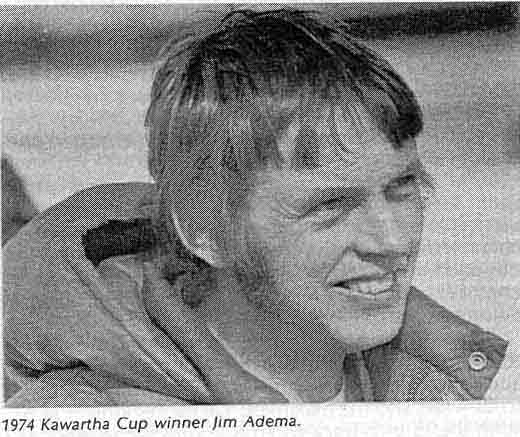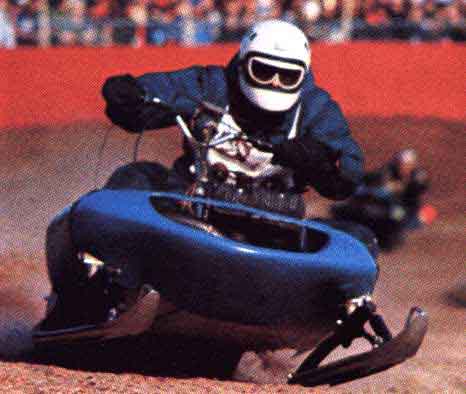

(All images are in Thumbnail format, so please click on them for the full screen version)
Also check out these two sections: Thunder Jet History & Racing and Rare Stuff
In Michigan, a young husband and wife team raced Sno*Jets for Watercraft Sales Center. Jim Adema was on his way to the Michigan International Snowmobile Association's Class BB points title with nine victories and nice second place finishes during the season. His wife, Pat Adema was cleaning up in the Powder Puff Classes as well.
In the mountains of Colorado, as soon as the season was over, Sno*Jet engineer Duane Aho and the shrewd young racer from Michigan, Jim Adema, were testing a new concept. Aho had found out what he wanted to know about his first ThunderJet. It was too heavy. It was unstable. It didn’t handle. The new ThunderJet prototype was quite a bit different.
Jim was a brilliant man. He and Duane designed the Thunder Jet, and did a terrific job. It was low, wide, sleek and very quick. Gave the big factory teams real trouble. The limited edition modified racing machines would be available in four Yamaha “R” type engine sizes. Aho was anxious for the snow. Jim was in no hurry. He was ready to test his Sno*Jet fleet on the grass. Jim was well experienced with motors:
"In the late 1950's, Sam Adema, a Belmont Michigan, man bought an old washing machine engine at an auction. He took it home and gave it to his son, who built a go-kart for his new motor. Young Jim Adema wasn't happy, however. The go-kart was too slow. In just a few days, he had removed it was in the workshop with a sander, trying to shave the cylinder head to make the engine faster. A few years later, Jim and a friend built a go-kart with a Corvette engine that hit 137 miles per hour in the quarter-mile."
Below you will two pictures of Jim's homemade Liquid Cooled 292cc Yamaha Engine. He modified the F/A 292 R type engine, by adding a water jacket. (click on pictures for larger version)
1972, Peterborough, Ontario generated news that echoed throughout the world of snowmobile racing. No one was paying much attention to the low-profile blue machines Jim Adema unloaded in the pits. The quiet young man from Michigan, wearing a bulky blue parka, got the sport’s attention right away. Adema and his ThunderJets were devastating at Peterborough.
The first surprise was his unusual techniques on the track. Adema’s machines hugged the inside rail, even through the corners, while the rest of his competitors rode high and wild around the top fringe of the banked turns. Saturday, Adema won Ontario’s Modified C class, beating Polaris’ Bob Eastman. Ski-Doo won MOD A and MOD D, Arctic won MOD B, and Polaris won the open class.
Sunday, as the temperatures rose and the track turned to slush, Adema stole the crowd’s heart. It started with Arctic winning MOD B again, then Adema took over. He won MOD A, MOD C and MOD D. He was surprised when he discovered Sunday night he hadn’t won the Kawartha Cup. With the scoring system used in Peterborough, the larger modified classes were worth more points.
Adema came right back out on Monday, however, and turned his tricks on the factories again. He won Mondays MOD A and C titles, and rolled up enough points to win the Canadian World Cup. He gave the big factory teams something new to worry about as they left town, and drove toward Wisconsin.
He was still a bit star struck when he drove his inconspicuous trailer full of ThunderJets into the circus atmosphere of Eagle River. Peterborough was the first big race he’d entered. The only reason he went up there was because Sno*Jet asked him to go. Jim had been perfectly content racing in Michigan, where he did very well. The Peterborough experience gave him a different viewpoint.
It wasn’t easy to find Adema among the hundreds of semi-trailers, school buses, pickup trucks and trailers jammed into the Eagle River pits. But the rest of the manufacturers scouted around and found him. They wanted to get a good look at the wide, sleek blue racers. Adema had an answer to turning corners. He was holding the inside rail even better than Mike Trapp’s Yamaha had done the year before.
Jim Adema launched the Sno*Jet show, winning 250cc class handily. Then fellow Sno*Jet driver Lewis Buerman of Alexandria, Minnesota, beat Skiroules Gilles Villeneuve in the 340 class. Then Adema came out to win the 440cc class. Then young Kim Elmer and his ThunderJet won the 650cc class. Then Ski-Doo managed to take the 800cc class.
Kawartha Cup 1973, Jim Adema, from Michigan, put the pressure on. The Sno*Jet Thunder Jet jockey returned to the scene of his biggest triumph ever, this time with a much improved chance of winning the cup. He had won five classes the year before only to finish fourth in a complicated points system. This time, the system had changed.
Adema, the hood on his blue parka flying, won the 440 and 800cc classes on Saturday, though he wasn’t in the lead. On Monday, it was the 800cc class that would decide the champion. Adema won the Kawartha Cup. Runner up was Scott Hemming, a brilliant Stock Driver from Peterborough.
Sno Pro was added to the Kawartha Cup program. For the first time in its 11 year history, Jim Adema of Belmont, Michigan, successfully defended the Kawartha Cup title. Adema out classed a field of more than 1300 entries to win the Cup. He finished almost 80 points higher than runner up Jacques Villeneuve, a factory backed Alouette drive. And to accentuate the Sno*Jet power, Jim’s tiny wife Pat won the Molson Women’s cup. Peterborough’s Scott Hemming successfully defended his high point stock title.
January 20th, 1974, at the World’s Championship in Eagle River, Wisconsin, after winning MOD 0 and third in MOD I, Jim Adema’s sled broke down. He won a battle with Jacques Villeneuve in MOD IV, but the battle between the two took both out of MOD III and made Dave Corbett of Winnipeg, Manitoba a winner (Dave was also racing a thunderjet). Villeneuve put a ski in Adema’s track.
Ironwood, Michigan, December 13th and 14th 1975, Jim Adema was driving a Yamaha for the first time in his career, beat Mercury’s Doug Hayes in the 440cc class. Adema was following fellow Yamaha driver Dick Trickle down the backstretch. The time was approximately 4:30 p.m., according to eye witnesses. Heavy, wet snow was falling. A meeting of drivers had been held prior to the event to poll them about running in the rapidly approaching darkness. The vote was to race.
Trickle experienced engine trouble on the back straight and slowed down. Adema attempted to swerve past the stalled machine, but clipped it from behind. Adema lost control and was thrown an estimated 100 feet onto the track. He got to his feet, but Team Bombardier driver Yvon Duhamel was unable to avoid a collision. His Ski-Doo struck Adema at an estimated 70mph. A second machine, driven by Joe Wolfe of Michigan, also struck Adema. Neither driver could be faulted. It was an unavoidable situation.
Adema was pronounced dead on arrival at Ashland, Wisconsin, Memorial Hospital a few hours later. Adema was the first professional snowmobile racing fatality in the sport’s history. His death stunned the industry and thousands of racing fans.
Jim was a competitor who has won favor among racing fans because of his one-man war against the gleaming factory machinery and the men in colorful, custom-tailored suits. Adema’s motorhome and trailer were no match for the factory semi-trailer vans, either. He enjoyed the image he portrayed, but in reality, Jim’s shop and expertise were a match for all but the very best factories. He never took the time to look back upon all his achievements and bask in the respect he built for himself.
Jim missed quite a few award
presentations because as soon as the race was over, he was working on his
equipment for the next week. It wasn't unusual at all for him to
work 17 or 18 hours a day, seven days a week, to get ready. He
went to the races with one purpose- to win. He'd race anything at anytime,
and when he did, he wanted to beat you. If he couldn't, he'd go home and
figure out a way to do it next time. There was never any doubt about his
capabilities. Besides being an adept driver, Jim was a genius in the
fine art of preparation. A number
of companies in the snowmobile industry were interested in hiring him because of
his expertise.
Adema balked at a number of offers, however. He set a price, a substantial salary figure, which no factory was eager to pay. His change in loyalties from Sno*Jet to Yamaha came primarily because Sno*Jet was not racing.
Adema’s death re-opened all of the old and lingering questions about snowmobile speed and safety, especially those relating to the extremes involved in racing. The Snopro group got together and drew up some hard-line safety rules. The days of racing despite blinding snow, darkness and rough tracks were gone. It was time to stop playing “chicken.”
Adema's death was a tragedy, and shocked the whole racing industry. He is still known as the best modified racer.
Racing and Rare Stuff Info Pictures Viewers Sleds
Models History Restorations Parts and Advertising ID Tips Links Sno*Jet Mainpage
Some Photos and Information Courtesy of Warriors of Winter, by Bill Vint as well as Of Ice and Engines, by C.J. Ramstad and Bob Satran
COPYRIGHT 1998 BLAKE READ